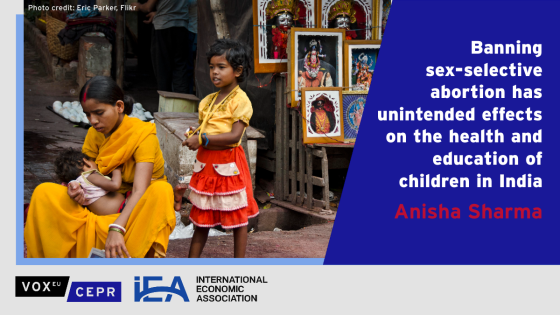Affirmative action – steps taken to increase the number of an under represented group in a certain field, such as more people of a certain race in politics – is a source of controversy wherever it goes (Bertrand et al. 2010). On the one hand, some believe that groups that have historically been discriminated against deserve policies that will improve their opportunities. On the other hand, some argue that such policies only benefit the elite individuals in a disadvantaged group or may place those minorities in environments they are not prepared for.
In a recent study we seek to add to the debate on affirmative action policies by examining the effect of one type of affirmative action, quotas in politics for certain ethnic groups or ‘political reservation’, on overall poverty in India. India accounts for one third of the world’s poor, with disadvantaged minority groups in India accounting for a disproportionate share of the poor in India. Poverty reduction is one of the stated goals of public policy, and India has seen a rapid decline in poverty over the 60 years in which its affirmative action policies have been in place. Yet so far, little is known about the effect of affirmative action policies on overall poverty in India. To what extent, if at all, are India’s affirmative action policies responsible for the decline in poverty?
It is possible that, if the benefits accrue only to the relatively well-off members of minority groups and hurt the less well-off members of non-minority groups, affirmative action could increase overall poverty. It therefore remains an open question whether affirmative action successfully reduces poverty.
In India, scheduled castes (SCs) are groups with low social and ritual standing, while scheduled tribes (STs) are those distinguished by their tribal culture and physical isolation. Both groups have been excluded from opportunities and rights, which has prevented them from improving their socioeconomic status in Indian society. In order to combat the historical discrimination against such groups, various affirmative action policies have been enacted in the Indian constitution. Among these policies is mandated representation for SCs and STs in the state legislative assemblies – each state must set aside a certain share of the seats in its legislative assembly that can only be held by SCs and STs members, with this share equal to the SC and ST share of the state population in the last preceding decennial census. In our research, we study the effect of political reservation of seats for SCs and STs in state legislative assemblies on overall poverty.
Does political reservation for minorities work?
In theory, minority political reservation could increase or decrease poverty. Previous studies have found that political reservations for minorities tend to change policies and the allocation of public goods in favour of minorities. Such changes can be expected to improve the wellbeing of at least some minorities, and even non-minorities in poverty might benefit to the extent that these changes encapsulate more general anti-poverty measures than would otherwise have been undertaken. However, there might be elite capture (in which only the better off among the minorities receive the benefits) or the displacement of resources for non-minorities in poverty. In India, although the poverty rate is higher among minorities (40% for SCs and STs compared with 23% for the rest of the population in 2004-05), the number of people in poverty is higher among non-minorities (12 million in poverty among SCs and STs compared with 17 million in poverty in the rest of the population). In this context, helping minorities is not synonymous with reducing poverty – it could be that benefits are mostly go to the SCs and STs above the poverty line, or that the costs are borne predominantly by the non-minority poor. Thus, it is an empirical question whether minority political representation overall reduces poverty. We estimate the impact of minority political reservation on poverty by using state panel data on the 16 major Indian states covering the period 1960-2000.
We find that SC political reservation had no impact on poverty while ST political reservation reduced both the incidence and intensity of poverty. Increasing the share of seats reserved for STs by one percentage point reduced poverty in India by 1.2 percentage points. Political reservation for STs has a greater effect on rural poverty than urban poverty, and appears to benefit people near the poverty line as well as those far below it. Our research provides evidence that, contrary to widespread belief, the benefits from affirmative action are not always captured by the better off. Indeed, in the case of political reservation for STs in India, the poor – including those far below the poverty line – have benefited too. Thus, minority political reservation is a policy that is both pro-minority and pro-poor.
Why the different effects?
It is intriguing that SC and ST political reservation have different effects on poverty. We explore three possible mechanisms:
- STs tend to be more geographically isolated;
- STs tend to live in less diverse communities; and
- STs have greater support for India’s Congress Party.
1. STs are more likely to live in local communities concentrated with other STs. SCs, though, are fairly evenly distributed throughout the state, and rarely make up a majority in their local communities. The geographic concentration of STs may facilitate the targeting of resources towards them (in other words, providing resources to STs without much slippage to other social groups). To test this story, we allow the effects of political reservations to vary by an index of isolation, measuring the likelihood that the average minority in a state will meet another minority, adjusting for the prevalence of minorities in the area. We do not find evidence that the poverty reduction effect is higher when SCs or STs are more geographically concentrated.
2. Within a local community, members of STs tend to be from the same specific scheduled tribe whereas there is more within-group heterogeneity among members of SCs (even in a given locality, there are numerous castes and subcastes within SCs). The greater homogeneity within the local community among members of STs may improve the efficacy of these resources (for example, more cooperative outcome, better delivery) (Alesina et al. 1999; Miguel and Gugerty 2005). To test this story, we allow the effects of reservation to differ by caste fragmentation. It appears that increasing caste fragmentation reduces the effectiveness of SC reservations in fighting poverty. However, caste fragmentation does not significantly affect ST reservation's effect on poverty; this makes sense because STs are typically not part of the Hindu caste system, so ST state legislators should not be materially adversely affected by caste fragmentation.
3. We consider the role of support for the Congress Party in explaining the differential impact of SC/ST reservation on poverty. The Congress Party has a strongly stated anti-poverty stance which originated in 1971, when Indira Gandhi campaigned for prime minister with “Garibi Hatao" (Abolish Poverty) as her slogan and won re-election. Thus, it seems natural to ask whether the larger effect of ST reservation on poverty that we find might be related to STs' more steadfast support for the Congress Party. Using two measures of support for Congress, both based on the share of reserved seats won by the Congress Party in the lower Parliament (Lok Sabha) we find the following. First, the effect of Congress Party share of Parliament seats on rural poverty is negative, which corroborates with the idea that increased support for the Congress Party is associated with lower poverty. Second, we find that ST reservation is more effective at reducing poverty where there is high support for Congress.
The impact of SC/ST reservation after the 73rd and 74th Constitutional Amendments
We test for whether the effect of reservation in the state legislative assemblies changed after the devolution of power. The 73rd and 74th Amendments to the Indian Constitution came into effect in April 1993, which formalised local government institutions and devolved more power from the state to local governments. These reforms also stipulate that one-third of local elected offices be reserved for women, and the reserved seats for SCs and STs be in proportion to their population.
We find that SC reservation has no effect on poverty either before or after 1993. However, ST reservation causes a larger reduction in rural poverty after 1993. The results suggest that that the 73rd amendment (which applied to rural governing bodies) enhanced the ability of ST reservations in the state legislature to fight poverty. The devolution of power, and mandated minority representation in local governing bodies, perhaps improved targeting and made the STs' preferences more salient, leading to an ultimate resource allocation that was more effective at reducing poverty.
What does this mean for India’s future affirmative action policies?
Overall, ours is the first study to quantity the effect of an affirmative action policy on poverty, and one of the few to estimate the overall effect of an affirmative action policy (as opposed to the effect on just the intended beneficiaries). We find that in the period from 1960-2000, SC political reservation had no effect on poverty while ST political reservation reduced the level and intensity of poverty. That one affirmative action policy, mandated representation for STs in the state legislative assembly, was effective at reducing poverty is an important finding, and one that counters the widespread belief that any benefits from the affirmative action policies are captured by the better off. That a very similar policy, mandated representation for SCs in the state legislative assembly, does not have the same impact on poverty is also an important finding, and implies that a simple replication of affirmative action policies from one group to other groups may have unexpected consequences, and that the specific context must be taken into careful consideration.
References
Alesina, Alberto, Reza Baqir, and William Easterly (1999), “Public Goods and Ethnic Divisions”, Quarterly Journal of Economics, 114(4):1243-1284.
Banerjee, Abhijit and Rohini Somanathan (2007), “The Political Economy of Public Goods: Some Evidence from India”, Journal of Development Economics, 82:287-314.
Burgess, Robin and Rohini Pande (2005), “Do Rural Banks Matter? Evidence from the Indian Social Banking Experiment”, American Economic Review, 95(3):780-795.
Chattopadhyay, Raghabendra and Esther Duflo (2004), “Women as Policy Makers: Evidence from a Randomized Policy Experiment in India”, Econometrica, 72(5):1409-1443.
Datt, Gaurav (1995), “Poverty in India 1951-92: Trends and Decompositions”, Policy Research Department, World Bank.
Dushkin, Lelah (1972), “Scheduled Caste Politics”, in J Michael Mahar (ed.), The Untouchables in Contemporary India, The University of Arizona Press, 917-961.
Galanter, Marc (1984), Competing Equalities: Law and the Backward Classes in India, University of California Press.
Pande, Rohini (2003), “Can Mandated Political Representation Increase Policy Influence for Disadvantaged Minorities? Theory and Evidence from India”, American Economic Review, 93(4):1132-1151.
Prakash, Nishith (2008), “Improving the Labor Market Outcomes of Minorities: The Role of Employment Quota”, University of Houston, Mimeo.


